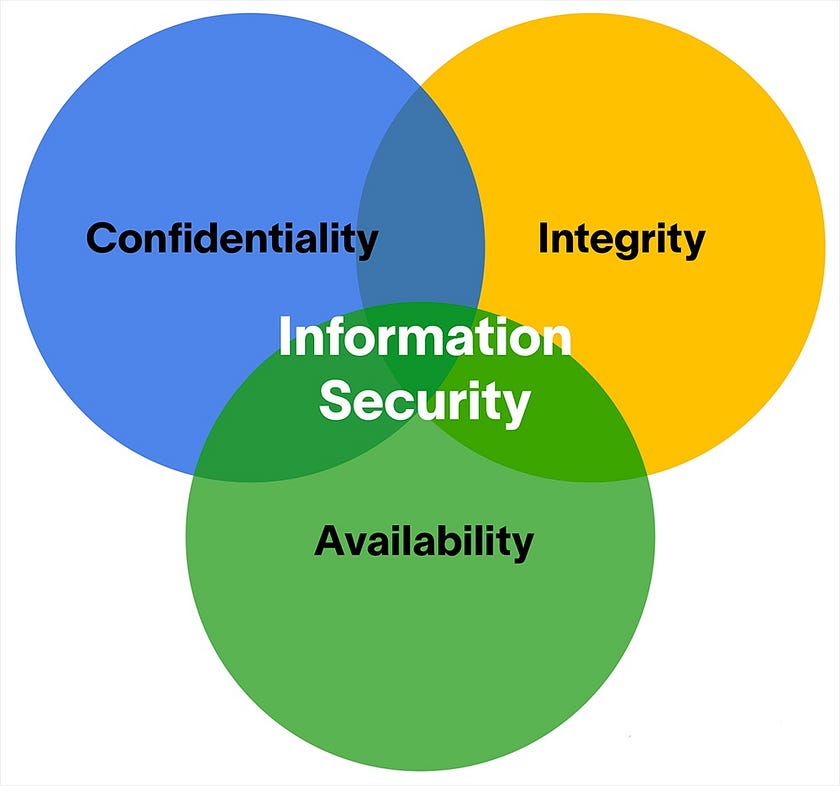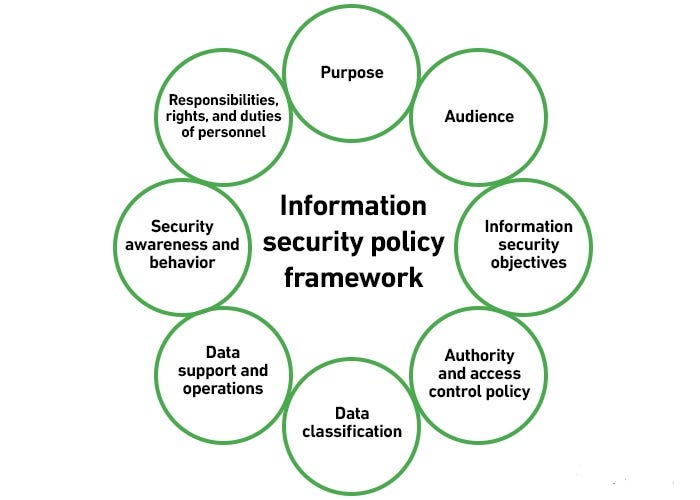How to Create an Effective and Usable Information Security Policy.

What is an Information Security Policy?
Security threats are constantly evolving, and compliance requirements are becoming increasingly complex. Organizations must create a comprehensive information security policy to cover both challenges. An information security policy makes it possible to coordinate and enforce a security program and communicate security measures to third parties and external auditors.
To be effective, an information security policy should:
- Cover end-to-end security processes across the organization.
- Be enforceable and practical.
- Be regularly updated in response to business needs and evolving threats.
- Be focused on the business goals of your organization.

The Importance of an Information Security Policy
Information security policies can have the following benefits for an organization:
- Facilitates data C.I.A. — Effective information security policies standardize rules and processes that protect against vectors threatening data C.I.A.
- Protects sensitive data — Information security policies prioritize the protection of intellectual property and sensitive data such as personally identifiable information (PII).
- Minimizes the risk of security incidents — An information security policy helps organizations define procedures for identifying and mitigating vulnerabilities and risks. It also details quick responses to minimize damage during a security incident.
- Executes security programs across the organization — Information security policies provide the framework for operationalizing procedures.
- Provides a clear security statement to third parties — Information security policies summarize the organization’s security posture and explain how the organization protects IT resources and assets. They facilitate quick response to third-party requests for information by customers, partner, and auditors.
- Helps comply with regulatory requirements — Creating an information security policy can help organizations identify security gaps related to regulatory requirements and address them.
12 Elements of an Information Security Policy
A security policy can be as broad as you want it to be, from everything related to IT security and the security of related physical assets, but enforceable in its full scope. I’ve compiled the following list detailing exactly the items I’ve included for every new security policy I had to revise, rewrite, draft, or reconstruct from beginning. The following list, in my humble opinion, offers some important considerations when developing an information security policy.
- Purpose
First state the purpose of the policy, which may be to:
- Create an overall approach to information security.
- Detect and preempt information security breaches such as misuse of networks, data, applications, and computer systems.
- Maintain the reputation of the organization, and uphold ethical responsibilities.
- Respect customer rights, including how to react to inquiries and complaints about non-compliance.
2. Audience
Define the audience to whom the information security policy applies. You may also specify which audiences are out of scope of the policy (for example, staff in another business unit which manages security separately may not be in the scope of the policy).
3. Information Security Objectives
Guide your management team to agree on well-defined objectives for strategy and security. Information security focuses on three main objectives:
- Confidentiality — Only individuals with authorization should access data and information assets.
- Integrity — Data should be intact, accurate, and complete, and IT systems must be kept operational.
- Availability — Users should be able to access information or systems when needed.

4. Authority and Access Control Policy
- Hierarchical Pattern — A senior manager may have the authority to decide what data can be shared and with whom. The security policy may have different terms for a senior manager vs. a junior employee. The policy should outline the level of authority over data and IT systems for each organizational role.
- Network Security Policy — Users are only able to access company networks and servers via unique logins that demand authentication, including passwords, biometrics, ID cards, or tokens. You should monitor all systems and record all login attempts.
5. Data Classification
The policy should classify data into categories, which may include “top secret, “secret,” “confidential,” and “public.” Your objective in classifying data is:
- To ensure that sensitive data cannot be accessed by individuals with lower clearance levels and without proper and/or authorized need-to-know (NTK).
- To protect highly important data, and avoid needless security measures for unimportant data.
6. Data Support and Operations
- Data Protection Regulations — Systems that store personal data, or other sensitive data — must be protected according to organizational standards, best practices, industry compliance standards, and relevant regulations. Most security standards require, at a minimum, encryption, a firewall, and antimalware protection.
- Data Backup — Encrypt data backup according to industry best practices. Securely store backup media, or move backup to secure cloud storage that is FedRAMP compliant.
- Movement of Data — Only transfer data via secure protocols. Encrypt any and all information copied to portable devices or transmitted across a public network.
7. Security Awareness and Behavior
Share IT security policies with your staff. Conduct training sessions to inform employees of your security procedures and mechanisms, including data protection measures, access protection measures, and sensitive data classification.
- Social Engineering — Place a special emphasis on the dangers of social engineering attacks (such as phishing emails, or over-the-shoulder surfing). Make employees responsible for noticing, preventing, and reporting such attacks.
- Clean Desk Policy — Secure laptops with a cable lock. Shred or burn-bag documents that are no longer needed. Keep printer areas clean so documents do not fall into the wrong hands.
- Encryption Policy — Encryption involves encoding data to keep it inaccessible to or hidden from unauthorized parties. It helps protect data-stored-at-rest/transit/motion between locations and ensures that sensitive, private, and proprietary data remains private. It can also improve the security of client-server communication. An encryption policy helps organizations define:
- The devices and media the organization must encrypt.
- When encryption is mandatory.
- The minimum standards applicable to the chosen encryption software.
8. Data Backup/Restoration Policy
A data backup and restoration/recovery policy defines rules and procedures for making online and offline backup copies of data. It is an integral component of overall data protection, business continuity, and disaster recovery strategy. Here are my top prioritized key functions that I normally, and that should be included in any data backup policy:
- Identify all information the organization needs to have backed up.
- Determine the frequency of backups, for example, when to perform an initial full backup and when to run incremental backups. (Pro-tip: it’s never a good idea to initiate full network backup’s during normal business hours. If’s a must, then yes, if absolutely not necessary, wait until afterhours when most have gone home and are off the network).
- Define a storage location (onsite and offsite, hot, cold, warm locations) for storing internal backup data.
- List all roles in charge of backup processes, for example, a backup administrator and members of the IT team.
9. Responsibilities, Rights, and Duties of Personnel
Appoint staff to carry out user access reviews, education, change management, incident management, implementation, and periodic updates of the security policy. Responsibilities should be clearly defined as part of the security policy.
10. System Hardening Benchmarks
The information security policy should reference security benchmarks, baselines, reference guides, best practices the organization will use to harden mission critical systems, such as the Defense Information Systems Agency (DISA), US-CERT, or Center for Information Security (CIS) benchmarks for Linux, Windows, Server, AWS, and Kubernetes.
11. References to Regulations and Compliance Standards
The information security policy should reference regulations and compliance standards that impact the organization, such as GDPR, CCPA, PCI DSS, SOX, and HIPAA.
9 Best Practices for Successful Information Security Policies
1. Information and Data Classification — Helps an organization understand the value of its data, determine whether the data is at risk, and implement controls to mitigate risks.
2. Developers, Security, and IT Operations — Should work together to meet compliance and security requirements. Lack of cooperation between departments may lead to configuration errors. Teams that work together in a DevSecOps model can coordinate risk assessment and identification throughout the software development life cycle (SDLC) to reduce risks.
3. Security Incident Response Plan (IRP) — Helps initiate appropriate remediation actions during security incidents. A security incident strategy provides a guideline, which includes initial threat response, priorities identification, and appropriate fixes.
4. SaaS and Cloud Policy — Provides the organization with clear cloud and Software-as-a-Service (SaaS) adoption guidelines, which can provide the foundation for a unified cloud ecosystem. This policy can help mitigate ineffective complications and poor use of cloud resources. (Pro-tip: When choose or working with a CASB, make sure they’re FedRAMP compliant).
5. Acceptable Use Policies (AUPs) — These are my favorite to create. AUPs help prevent data breaches that can occur through misuse of company resources. Transparent AUPs help keep all personnel in line with the proper use of company technology resources. …why are they my favorite? Because I get to learn a whole lot more about the ins and outs of the organization (faster than those who aren’t revising or creating from scratch, an AUP).
6. Identity and Access Management (IAM) Regulations — IAM policies, procedures, and regulations are no joke. IAM is considered a defense-in-depth strategy to help bolster security overall. IAM is the crux in any network to preserving and safeguarding identity and privacy. Let IT administrators authorize systems and applications to the right individuals and let employees know how to use and create passwords in a secure way (Pro-tip: Try and avoid numerical/non-numerical passwords and shoot for MFA/2FA/Biometrics/PKI/RSA/Kryptonite PAM, if you can).
7. Data Security Policy — Outlines the technical operations of the organization and acceptable use standards in accordance with the Payment Card Industry Data Security Standard (PCI DSS) compliance.
8. Privacy Regulations — Government-enforced regulations such as the General Data Protection Regulation (GDPR) and Freedom of Information Act (FOIA) protect the privacy of end-users. Organizations that don’t protect the privacy of their users risk losing their authority and may be fined heavily.
9. Personal and Mobile Devices — Nowadays, most organizations have moved to the cloud. Companies that encourage employees to access company resources and/or software assets from any location, risk introducing vulnerabilities through personal devices such as laptops and smartphones. Creating a policy for proper security of mobile devices can help prevent exposure to threats and employee-owned assets.
